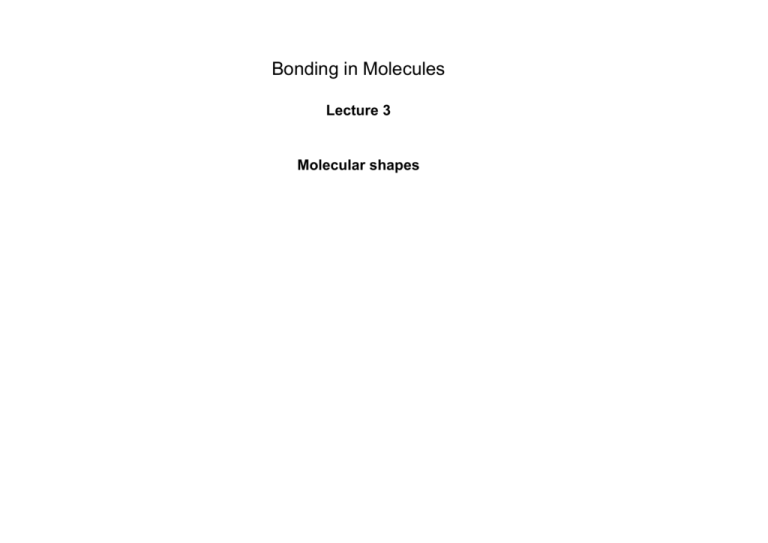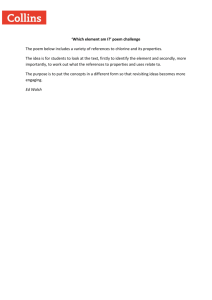Lecture 3
advertisement

Bonding in Molecules Lecture 3 Molecular shapes Known shape of some AH2 molecules Molecular species No. of valence electrons Shape LiH2+ 2 Bent LiH2, BeH2+ 3 Linear BeH2, BH2+ 4 Linear BH2, AlH2, CH2+ 5 Bent CH2, SiH2, BH2-, NH2+ 6 Bent NH2, PH2, CH2-, OH2+ 7 Bent OH2, SH2, NH2-, FH2+ 8 Bent Molecular species angle BH2 131 CH2 110 SiH2 93 NH2 103 OH2 104.5 SH2 92.1 FH2+ 118 D∞h C2v Walsh diagram poorer overlap of H1s with 2px remains non-bonding better overlap of H 1s orbitals First order effects Walsh diagram mixing can occur between 2 orbitals because they both transform as a1 in the lower symmetry A second order effect (often called a second order Jahn Teller distortion) 1 ∝ ∆E Walsh diagram Known shape of some AH2 molecules Molecular species No. of valence electrons Shape LiH2+ 2 Bent LiH2, BeH2+ 3 Linear BeH2, BH2+ 4 Linear BH2, AlH2, CH2+ 5 Bent CH2, SiH2, BH2-, NH2+ 6 Bent NH2, PH2, CH2-, OH2+ 7 Bent OH2, SH2, NH2-, FH2+ 8 Bent Recall: a molecule adopts the structure that best stabilises the HOMO. If the HOMO is unperturbed by the structural change under consideration, then the occupied MO lying closest to it governs the geometric preference. Walsh diagram OH2 vs SH2 vs SeH2? VSEPR? Decreased s/p hybridisation? (note bonding with pure p orbitals implies 90°angles) 1a12 1b22 + 2a11 BH2 AlH2 2a12 131 119 2a12 1b11 2a12 1b12 CH2 110 NH2 103 OH2 104.5 NH2+ 115-120 OH2+ 110.5 FH2+ 118 BH2- 102 CH2- 99 NH2- 104 SiH2 93 PH2 92 SH2 92.1 AsH2 91 SeH2 90.6 TeH2 90 D∞h 2 x ‘sp’ hybrids + 2 x p lone pairs C2v 3 x ‘sp2’ hybrids + 1 x p lone pair more p character in bonding orbitals 2nd order JT effect mixes s character (originally in 2σg) into the lone pair (1πu) so more p character accumulates in the bonding orbitals. Strength of 2nd order JT effect proportional to 1/∆E 2 factors to consider: Decrease in electronegativity destabilises πu 3/4s orbitals of S/Se are lower than 2s of O (increased penetration) and also overlap more weakly with H 1s because they are diffuse. Both factors stabilise σg both make 2nd order JT effect stronger in the heavier elements PES revisited: origin of fine structure PES revisited: origin of fine structure PES revisited: HF (0,0) band most intense higher band most intense narrow band PES revisited: H2O (0,0) band most intense The shapes of H3+ and H3-: 1st order JT effects, 3-centre-4-electron and 3-centre-2-electron bonds Consider MOs for the 2 limiting shapes for a 3-atom system: linear (D∞h) and triangular (D3h) D3h (using the SALCS given in the handout) The shapes of H3+ and H3-: 1st order JT effects, 3-centre-4-electron and 3-centre-2-electron bonds Consider MOs for the 2 limiting shapes for a 3-atom system: linear (D∞h) and triangular (D3h) D∞h Walsh diagram increasing destructive overlap of terminal H 1s increasing constructive overlap of terminal H 1s Walsh diagram (1st order) Jahn-Teller theorem If a non-linear molecule is in an orbitally degenerate state, it will distort to remove the degeneracy orbitally degenerate therefore a first-order JT distortion H3(a 3-centre-4-electron bond) c.f. hypervalent species such as HF2-, XeF2 H3+ (a 3-centre-2-electron bond) c.f. electron deficient species such as boranes Bonding in Hypervalent Molecules XeF2 (‘hypervalent’ = 10 electrons on Xe) Possible explanations? sp3d hybridisation? Ionic resonance forms? Bond order 0.5 Symmetry analysis (D∞h)








